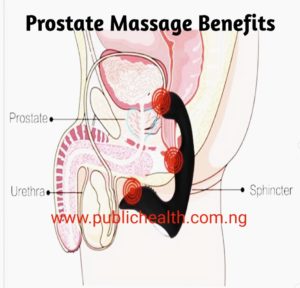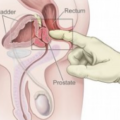Prostate massage or milking of the prostate involves direct stimulation of the prostate gland with the goal of expressing prostatic fluid, with or without orgasm. Massaging of the prostate spontaneously leads to the secretion of prostatic fluid otherwise known as prostate milk. Stimulating or milking both sides of the prostate gland for about 20 minutes produces a highly pleasurable sensation that results in a highly orgasmic prostate ejaculation known as super orgasm. This orgasm can be way more intense than an orgasm and ejaculation achieved during personal stimulation or sexual intercourse.
What are The Health Benefits of Prostate Milking and Massage?
There are several reasons why people engage in the practice of prostate stimulation. In this section, we will explore some of the health benefits of prostate massage therapy, prostate stimulation, milking, and massage. Milking the prostate gland benefits includes:
- Pain Reduction – One of the benefits of prostate massage therapy is pain relief. The fluid secretion from the prostate gland is often helpful in reducing the pain that is associated with prostate conditions. Frequently flushing the prostate by milking can prevent the development of further prostate disorders. Prostate massage and milking therapy may also ease fluid blockages in your reproductive system and relieve discomfort or pain while ejaculating.
- Medical Benefits such as Prostate Digital Examination (PDE) – Prostate massage and milking the prostate medical procedure is actually a part of Prostate Digital Examination (PDE). It is carried out to detect prostate cancer nodules and obtain prostatic secretion (EPS) specimens for prostatitis screening.
- Risk of Cancer Reduction – The information provided by the PDE procedure is very important for the improvement of prostate health and the prevention and reduction of risk related to cancer. Read: Do Prostate Massages Help Prevent Cancer
- Boost Testosterone Levels – The process of prostate milking and massage is accompanied by a lot of sensations that could boost testosterone levels. In a study published in the archives of sexual behavior published on springer, the researchers took saliva samples of testosterone from their 44 subject males before they entered a sex club and then waited outside for them to return to take another sample. They found out that the men who had sex inside with a woman, experienced a 72% increase in testosterone, whereas the men who only watched the act, noticed an 11% increase in the hormone. Orgasm is associated with testosterone increase. Before the advent of modern methods of treating erectile dysfunction, prostate massage and milking were used to treat erectile dysfunction (ED).
- Erectile dysfunction Treatment – Prostate stimulation can help men with erectile dysfunction by increasing blood flow to the penis since erectile dysfunction is significantly due to a lack of blood flow. In some parts of the world, some men still use this benefit of prostate massage therapy to overcome or cure premature ejaculation either alone or in combination with other treatments for erectile dysfunction. Read: Why Do I Ejaculate Quickly
- Ease of Urination – Another benefit of prostate massage therapy is the ease of urination. The prostate surrounds your urethra and prostatitis is characterized by urinary problems such as burning or painful urination, the urgent need to urinate, trouble voiding, difficult or painful ejaculation, and pain in the area between the scrotum and rectum (known as the perineum) or lower back. If prostate massage therapy helps eliminate some of that swelling, your urine flow may improve significantly.
- Benign Prostatic Hyperplasia (BPH) – Prostate Massage is used to treat an Enlarged Prostate (BPH). Prostate massage has been shown to be effective in relieving the symptoms of an enlarged prostate. Prostate massage treatments can help improve blood flow in the prostate and help reduce the size of the prostate gland and in turn relieve the symptoms. This is something you can do at home in the comfort of your shower and only takes a few minutes per day, a few times a week.
How to Improve Prostate Health
There are several ways to improve prostate health and reduce your risk of developing prostate cancer apart from prostate milking procedures, these include:
- Maximize your intake of fruits and vegetables, they are excellent sources of anticancer and anti-inflammatory compounds such as antioxidants.
- Eat healthy fatty fish such as salmon, they are rich in omega 3 fats which help to fight inflammation, a process that destroys the body’s natural antioxidants and weakens the immune system, in addition, choose plant protein over animal protein.
- Eat whole and natural foods rich in fiber, they help lower the levels of testosterone and lower PSA scores.
- Consume green tea contain catechins a type of antioxidant that can slow cancer cell growth, and promote cancer cell death.
- Avoid foods and additives that harm the prostate such as red meat, calcium, chondroitin, and foods high in sugar they undermine prostate health.
- Consume foods and supplements with cancer-killing properties such as lycopene, turmeric/curcumin, folic acid, and vitamin D.
- Maintaining a healthy weight, and being overweight or obese are linked with a higher risk of prostate cancer, and a lower long-term survival rate.
- Exercising regularly not only helps slow the spread of prostate cancer but also has a preventive effect on inflammation, prostatitis, and BPH.
- Manage stress, long-term stress can weaken the immune system, alter your hormonal balance, and make you more susceptible to illnesses and diseases. SEE Prostate Massage Therapy For Erectile Dysfunction
The top Five Foods to Eat for a Healthy Prostate
Fish: Certain fish (especially cold-water fish like salmon, sardines, and trout) provide “good fats” that help prevent inflammation in the body. Over the past few years, scientists have begun to see inflammation within the prostate as a dangerous condition that can make it easier for cancer to take hold. Omega 3 fatty acids (you may have heard about them as EPA and DHA), are essential fats that our bodies can’t make, so we need to get them from food sources. If you aren’t wild about fish, you can find another “good fat,” called ALA (for “alpha linolenic acid,” which is the plant-based form of Omega 3 fatty acids), in seeds, nuts, olive oil, and other vegetable oils. The Health Professionals Follow-Up study followed 4,577 men with localized prostate cancer (confined within the prostate) over a 24-year period and found that participants who replaced animal fat with vegetable fat had a lower risk of dying from their cancer.
Berries: “Oxidative damage” is what scientists call incremental damage that builds up over many years. It’s caused by “oxygen free radicals,” which are toxic byproducts of metabolism. When uncontrolled, free radicals wreak havoc on the body causing oxidative damage and disease. Antioxidants help to neutralize and remove free radicals from the body. Berries are a great source, particularly strawberries, blackberries, blueberries, and raspberries (the brighter the better). These fruits offer up powerful antioxidants known as anthocyanins.
Cooked tomatoes: Lycopene is another powerful antioxidant and is found in the cell walls of tomatoes. The cooking process loosens the bond, making it easier for our bodies to access the antioxidant and send it to the prostate. Tomato sauce, paste, juice, and sundried tomatoes help our bodies make the most of this nutritional superstar. Even better: tomatoes cooked in olive oil.
Broccoli: Broccoli contains the phytochemical (Phyto means “plant”) sulforaphane, which is suspected to target and kill cancer cells while leaving healthy prostate cells to fight another day. Studies suggest that eating cruciferous vegetables can lower your risk of getting prostate cancer. Don’t like broccoli? There are other vegetables in the same family that have similar beneficial effects, including cabbage, bok choy, kale, cauliflower, and Brussels sprouts.
Green Tea: Another great source of antioxidants, this versatile leaf contains multiple antioxidant compounds called catechins (most important are two called EGCG, for epigallocatechin-3-gallate, and epicatechin), which are believed to be anti-carcinogenic and anti-mutagenic (preventing healthy cells from mutating). A review of multiple studies found that men who drank five cups of green tea per day had a decreased risk of prostate cancer. By increasing your intake of healthy fats, antioxidants, and anti-inflammatory foods, you can help keep your prostate healthy. In the words of Socrates: “Let food be thy medicine.”





